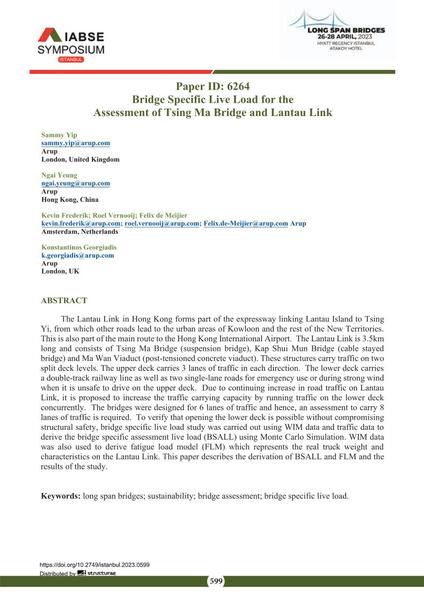Bridge Specific Live Load for the Assessment of Tsing Ma Bridge and Lantau Link

|
|
|||||||||||
Bibliographic Details
| Author(s): |
Sammy Yip
(Arup, London, United Kingdom)
Ngai Yeung (Arup, Hong Kong, China) Kevin Frederik (Arup Amsterdam, Netherlands) Roel Vernooij (Arup Amsterdam, Netherlands) Felix de Meijier (Arup Amsterdam, Netherlands) Konstantinos Georgiadis (Arup, London, UK) |
||||
|---|---|---|---|---|---|
| Medium: | conference paper | ||||
| Language(s): | English | ||||
| Conference: | IABSE Symposium: Long Span Bridges, Istanbul, Turkey, 26-28 April 2023 | ||||
| Published in: | IABSE Symposium Istanbul 2023 | ||||
|
|||||
| Page(s): | 599-606 | ||||
| Total no. of pages: | 8 | ||||
| Year: | 2023 | ||||
| DOI: | 10.2749/istanbul.2023.0599 | ||||
| Abstract: |
The Lantau Link in Hong Kong forms part of the expressway linking Lantau Island to Tsing Yi, from which other roads lead to the urban areas of Kowloon and the rest of the New Territories. This is also part of the main route to the Hong Kong International Airport. The Lantau Link is 3.5km long and consists of Tsing Ma Bridge (suspension bridge), Kap Shui Mun Bridge (cable stayed bridge) and Ma Wan Viaduct (post-tensioned concrete viaduct). These structures carry traffic on two split deck levels. The upper deck carries 3 lanes of traffic in each direction. The lower deck carries a double-track railway line as well as two single-lane roads for emergency use or during strong wind when it is unsafe to drive on the upper deck. Due to continuing increase in road traffic on Lantau Link, it is proposed to increase the traffic carrying capacity by running traffic on the lower deck concurrently. The bridges were designed for 6 lanes of traffic and hence, an assessment to carry 8 lanes of traffic is required. To verify that opening the lower deck is possible without compromising structural safety, bridge specific live load study was carried out using WIM data and traffic data to derive the bridge specific assessment live load (BSALL) using Monte Carlo Simulation. WIM data was also used to derive fatigue load model (FLM) which represents the real truck weight and characteristics on the Lantau Link. This paper describes the derivation of BSALL and FLM and the results of the study. |
||||
| Keywords: |
sustainability bridge assessment Long span bridges bridge specific live load
|
||||
